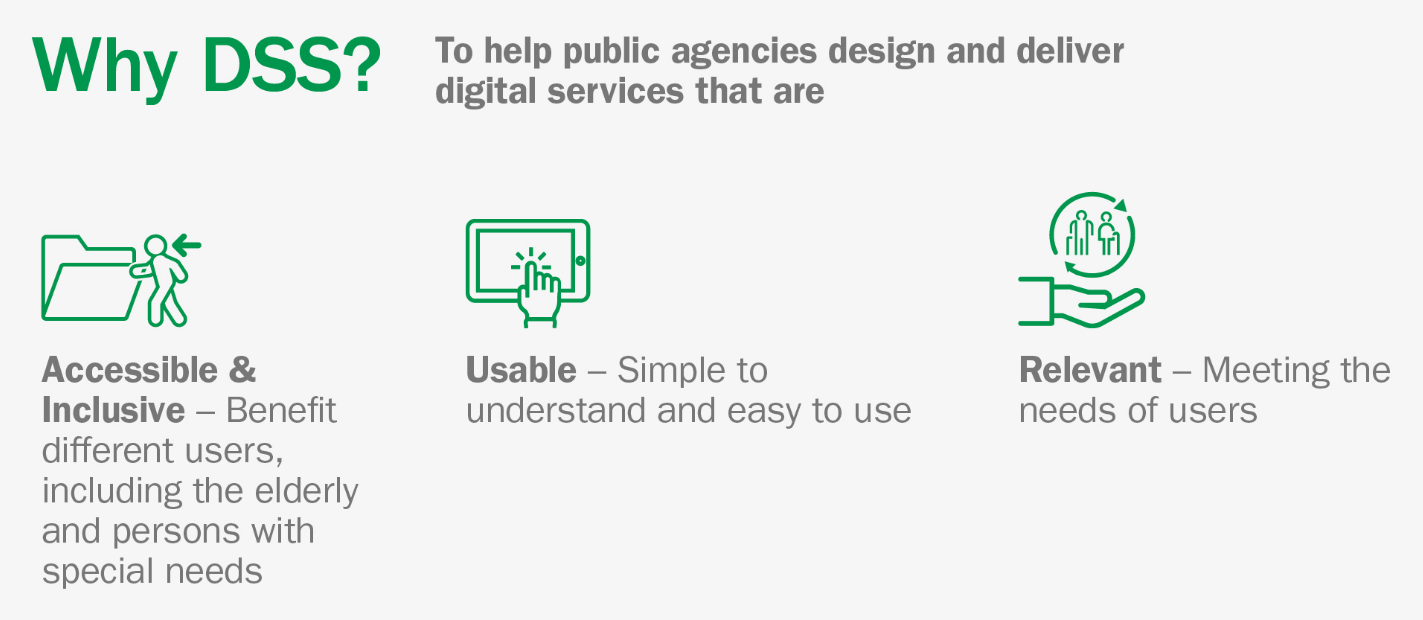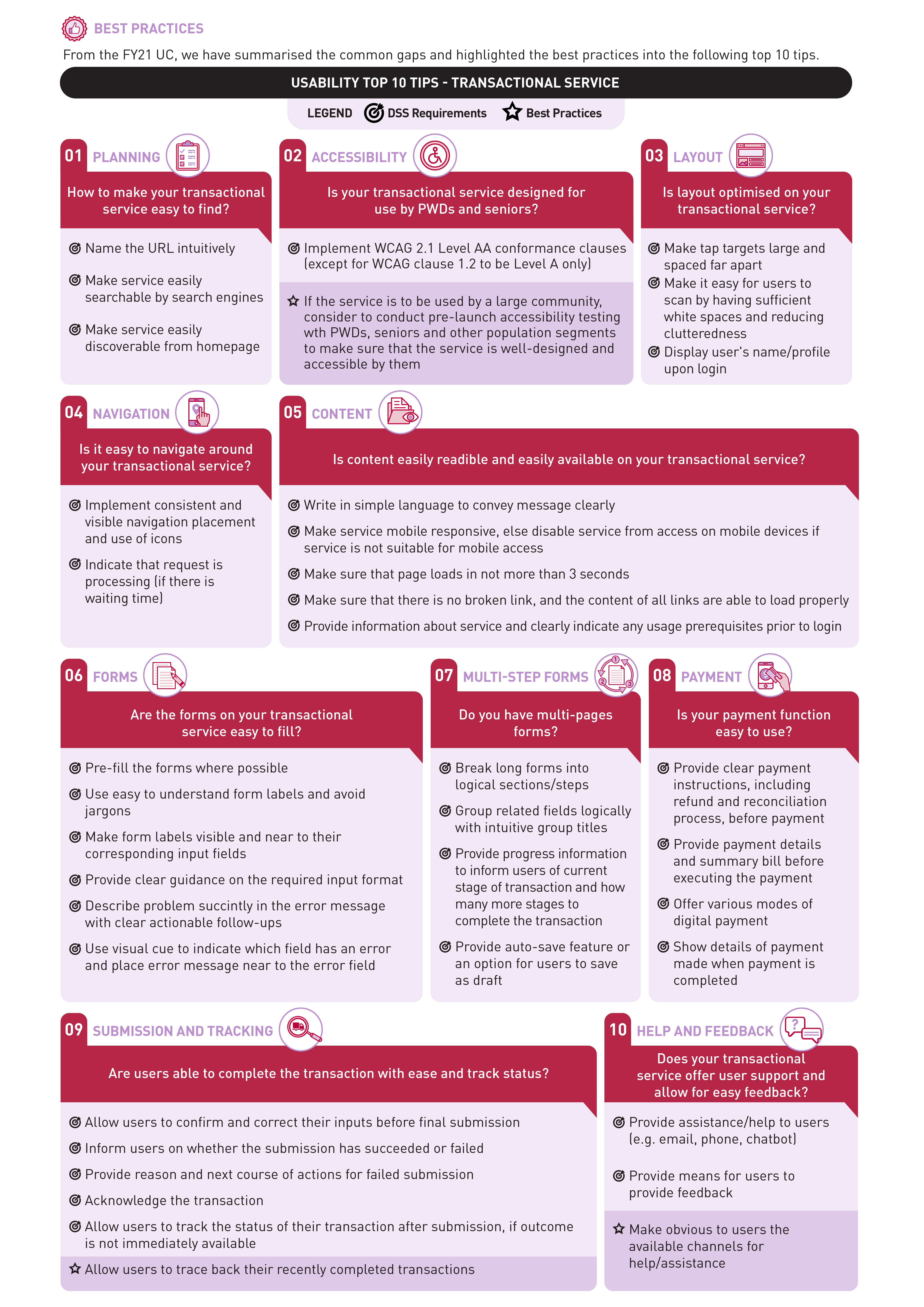What is the DSS?
The Digital Service Standards (DSS) is a set of policies, standards and guidelines which helps Government agencies in implementing digital services to meet the Digital Government Blueprint (DGB) goal of delivering digital services that are easy to use, seamless and relevant to citizens and businesses. All Government digital services must meet the DSS.
An updated version of the DSS was released in July 2020, to access it, click on this link.
Why was the DSS Implemented?
The core of the Singapore Government digital transformation journey is to identify user needs in order to design and deliver unified and consistent digital services to citizens and businesses. We adopt an outside-in and co-creation approach with benchmarks against international best practices to ensure that our DSS is relevant and can help agencies to uplift their digital services.

How was the DSS Created?
We obtain insights on user needs from citizens, businesses and the Government. Examples of how we do so are shown below:
Citizens
- Feedback is obtained through mystery shopper checks by citizens on our digital services.
- Public feedback obtained on our digital services.
Businesses
- Observation of the latest industry developments.
- Consultations with the industry
Government
- Government’s strategic plans such as the DGB.
- Ground-up initiatives related to user experience (UX) from GovTech’s Capability Centres.
- Specialist knowledge from Smart Nation Fellows on digital design.
- Consultations with engineering communities and agencies within the Government.
- Reference from relevant national standards, such as the SS618 on designing for older adults.
We also base our usability heuristics research on industry and international best practices (e.g. Web Content Accessibility Guidelines/WCAG). We also take reference from other leading Governments.
Iterative Development
GovTech advocates for an Agile-first delivery so DSS was developed using an iterative development approach. It was co-created with a cross-disciplinary team (e.g. policy specialists, user experience experts etc) before the beta version of DSS was released to selected agencies as a minimum viable product (MVP). Based on their feedback and extensive consultations with our engineering, business community and Government agencies, the MVP was refined before it was published. Till now, the DSS continues to be regularly enhanced with a similar iterative approach.
Design Principles of DSS
Intuitive Design and Usability
Digital services are designed according to the DSS to help users:
- Identify, access and navigate services easily.
- Track and monitor transactions more efficiently.
- Complete a transaction or interaction more effortlessly.
Accessibility and Inclusivity
- Perceivable design ensures content is available in forms such as speech, large print or Braille.
- Operable design ensures functions are accessible through a keyboard, mouse or other assistive devices.
- Understandable content that is clear, concise and avoids jargon.
- Robust services that can be accessed across devices.
Relevance and Consistency
- Adoption of common design elements such as a standard masthead for consistent user experience.
- Conducting regular reviews to ensure content and services are up to date.
- Provision of clear and relevant content.
DSS in Government Digital Services
An example of the Digital Service that has embraced DSS in its delivery is the LifeSg app (previously known as Moments of Life). It was conceptualised in June 2017 to develop a tool that can consolidate citizen-facing services delivered by different Government agencies onto a single platform. Its first release in June 2018 focused on the very beginning of a citizen’s journey, which was childbirth. It allowed birth registrations, access to baby’s immunisation records, navigation of healthcare and childcare options eligible for benefits, and application of the Baby Bonus Scheme (a government programme aimed at alleviating the financial costs of parenthood). Since then, the app has been enhanced to support other critical moments of life, such as ageing and caregiving. The overarching goal for LifeSG has evolved to provide a suite of digital solutions for citizens well-being that covers critical moments “from the cradle to grave.”
Usability Checks to improve Government Digital Services with DSS
Usability Checks (UC) are conducted periodically by independent citizens and businesses to ‘mystery-shop’ and check on the usability and accessibility of Government digital services when benchmarked against DSS. From the usability check (UC), key learning points are also curated for our agencies to further improve on their digital services.
An example is the “Usability Top 10 Tips for Transactional Service” which is curated from a recently completed UC on transactional services in March 2022:

Contact Information
For enquiries on DSS, email info@tech.gov.sg.
Other Resources
- Download the DSS Infographic
Disclaimer: This page does not set out the full set of compliance requirements under the Instruction Manual (IM) for ICT&SS Management. Please approach your agency’s intranet resources for more information on the IM for ICT&SS Management.
Last updated 26 January 2024
Thanks for letting us know that this page is useful for you!
If you've got a moment, please tell us what we did right so that we can do more of it.
Did this page help you? - No
Thanks for letting us know that this page still needs work to be done.
If you've got a moment, please tell us how we can make this page better.

